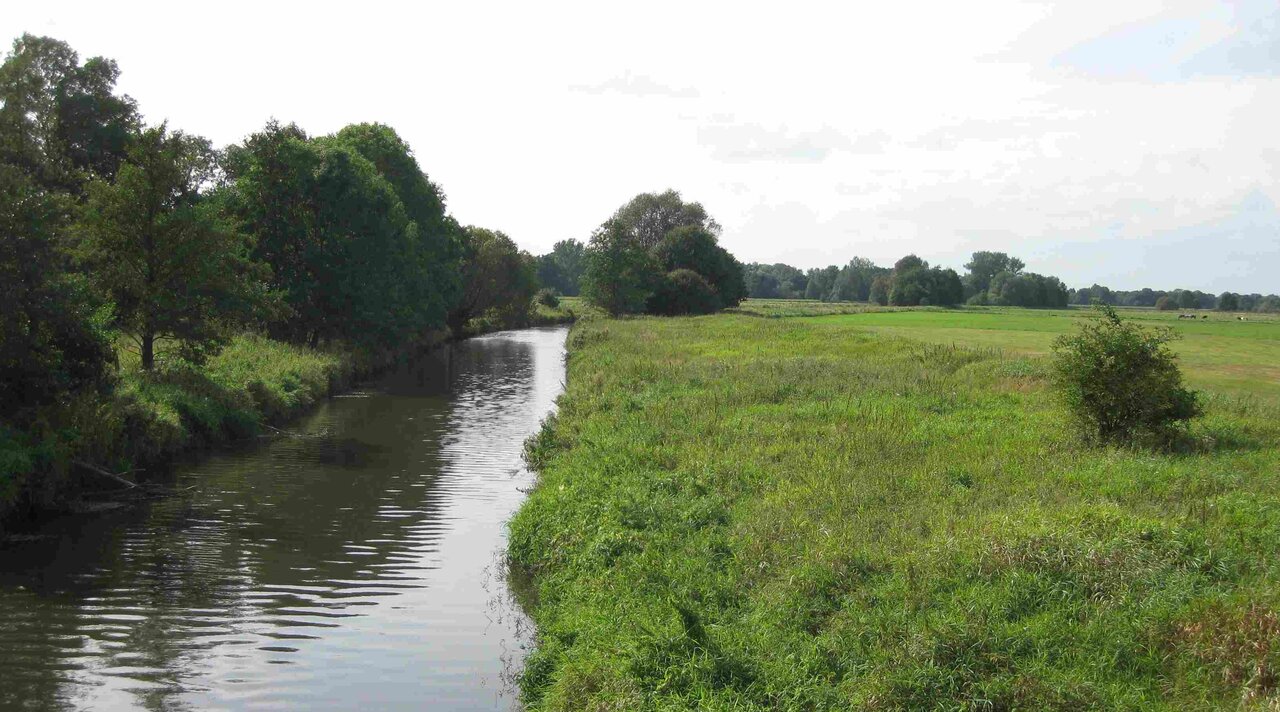Project
Mapping regional agricultural nitrogen fluxes for water and climate protection policy (RELAS)

Mapping of regional agricultural nitrogen fluxes as basis for the development and optimisation of agricultural policy measures to achieve climate protection targets
Numerous policy measures have already been implemented in the past with the aim of reducing nitrogen emissions. For the further development of water and climate protection measures, a cross-media consideration of agricultural nitrogen fluxes in soil, groundwater, surface waters and the atmosphere is essential.
Background and Objective
In 2018, the European Court of Justice convicted the Federal Republic of Germany for failing to implement the Nitrates Directive (Case C-543/16). Many areas in Germany have nitrate levels in groundwater above the legal threshold of 50 mg/l. The requirements for fertiliser management in agriculture were tightened in 2020 by the amendment of the Fertiliser Application Ordinance. In order to recognise the need for early remedial action in nitrate-polluted areas and to prevent negative developments in previously unpolluted areas, a nationwide monitoring system is to be set up in Germany that will allow statements to be made at short intervals on the effectiveness of the measures taken.
The agro-economic-hydrological model network AGRUM Germany, in which the Thünen Institute of Rural Areas participates with the Regionalised Agricultural and Environmental Information System for Germany (RAUMIS), is a central component of the monitoring. We model nutrient emissions from agricultural and non-agricultural sources and their inputs to groundwater, surface waters and marginal seas. This is intended to provide insights into the links between the short- and long-term effects of nutrient reduction measures. The short-term effects concern nutrient surpluses, the level of which depends on fertiliser management, but also on site and weather conditions. The nutrient concentrations and loads in water bodies, on the other hand, are influenced by a variety of regional factors (fertilisation practices, climate, precipitation, soil properties, retention, etc.) over a period of several years to decades.
Since nitrogen compounds not only pollute waters (nitrate), but also play a major role as an air pollutant (ammonia) and as a greenhouse gas (nitrous oxide), we are pursuing cross-system modelling approach together with the Thünen Institute of Climate-Smart Agriculture, the Jülich Research Centre and the Leibniz Institute of Freshwater Ecology and Inland Fisheries. In the process, the nitrogen fluxes in soil, water bodies and the atmosphere are quantified holistically and made usable for climate reporting.
In the monitoring system, the modelling of mass flows is flanked by data on farm fertilisation (emissions) and on nitrate and phosphate concentrations in surface waters and groundwater bodies (immissions). In addition, outside the RELAS project, the Julius Kühn Institute collects measurement data on the nutrient situation of farms in model regions in order to gain insights into the effect of measures of the Fertiliser Application Ordinance on individual areas.
The mapping of regional agricultural nitrogen fluxes will improve both the data basis of the emission inventories of climate reporting as well as climate reporting itself.
In summary, the RELAS project aims to make important contributions to water protection (development of an impact monitoring system for the Fertiliser Application Ordinance) and climate protection (improvement of climate reporting) with the spatially differentiated mapping of agricultural nitrogen fluxes in Germany.
Target Group
Policy makers (European Commission, Federal Government, Länder), agricultural and water management authorities, farm managers, environmental organisations, farmers' associations, interested members of the public.
Approach
The project is coordinated by the Thünen Institute of Rural Studies. It is divided into the following sub-tasks:
- Building the data infrastructure
- Indexing, processing, merging and plausibility checking of spatially high-resolution data bases
- Development of routines for standardised data preparation for emission calculations and modelling
- Further development of the model system AGRUM Germany: model-based representation of spatially differentiated agricultural nitrogen fluxes, modelling of nitrogen and humus stocks in the soil as a function of agricultural management, improvement of the calculation of nitrous oxide and ammonia emissions as well as nitrate leaching from agricultural soils, improvement of the modelling of nitrous oxide emissions caused by denitrification in surface waters.
- Impact assessments of selected policy measures
- Provision of results to the public, assistance for the annual reporting to the European Commission
The large amount of input and result data is compiled and managed in a central database at the Thünen Institute. For the continuation of the monitoring, routines are being developed that allow recurring data evaluations, analyses and generating input for the reports of the Federal Republic of Germany to the European Commission and provide both authorities and the public with detailed environmental information on the nutrient situation.
Data and Methods
As far as possible, data from the following sources are acquired, processed and compiled as a basis for the data:
IACS (Integrated Administration and Control System), HIT database, test farm statistics, Animal Disease Fund, data from the administrative enforcement of the Fertiliser Application Ordinance, the Farm Manure Transfer Ordinance, the Sewage Sludge Ordinance and the Biowaste Ordinance.
The interdisciplinary model network AGRUM Germany is being continued and further developed in the RELAS project.
Thünen-Contact

Involved Thünen-Partners
- Brandes, ElkeLV Institute of Rural Studies
- Dechow, ReneAK Institute of Climate-Smart Agriculture
- Eysholdt, MaxLV Institute of Rural Studies
- Fuß, RolandAK Institute of Climate-Smart Agriculture
- Löw, PhilippLV Institute of Rural Studies
- Mattner, ClaraLV Institute of Rural Studies
- Ouattara, BorisAK Institute of Climate-Smart Agriculture
- Zahra, SamerLV Institute of Rural Studies
Involved external Thünen-Partners
-
Leibniz-Institut für Gewässerökologie und Binnenfischerei (IGB)
(Berlin, Deutschland) - Forschungszentrum Jülich
(Jülich, Deutschland)
Funding Body
-
Federal Office for Agriculture and Food (BLE)
(national, öffentlich)
Duration
9.2022 - 8.2025
More Information
Project status:
finished
Publications
- 0
Zinnbauer M, Löw P, Rothe M, Stever-Schoo B, Tetzlaff B, Trepel M, Venohr M, Wendland F (2025) Germany’s new impact monitoring on the effectiveness of the Nitrates Directive Action Program [Vortrag] [online]. In: International Interdisciplinary Conference on Land Use and Water Quality : Agriculture and the environment ; Aarhus, Denmark, 3-6 June 2025 ; Oral and poster presentations., zu finden in <https://www.luwq2025.nl/wp-content/uploads/2025/10/017_Zinnbauer_Impact_Monitoring_published.pdf> [zitiert am 04.12.2025]
- 1
Zinnbauer M (2024) Betriebliche Daten sind die Grundlage für DüV-Monitoring und Maßnahmendifferenzierung: Stellungnahme zur Anhörung im Ausschuss für Umwelt, Natur- und Verbraucherschutz, Landwirtschaft, Forsten und ländliche Räume (AULNV) im Landtag Nordrhein-Westfalens am 10. Juni 2024 zum Antrag der Fraktionen von CDU und BÜNDNIS 90/DIE GRÜNEN „Nachhaltige Landwirtschaft stärken - Natur und Menschen schützen: Verursacherprinzip im Rahmen der Düngegesetzgebung ambitioniert umsetzen“ [online]. [Stellungnahme 18/1520]. Braunschweig: Thünen-Institut für Lebensverhältnisse in ländlichen Räumen, 13 p, zu finden in <https://www.landtag.nrw.de/portal/WWW/dokumentenarchiv/Dokument/MMST18-1520.pdf> [zitiert am 05.06.2024]
- 2
Zinnbauer M, Löw P, Osterburg B, Weingarten P (2023) Zweites Gesetz zur Änderung des Düngegesetzes (Drucksache 20/8656): Stellungnahme zum Gesetzesentwurf der Bundesregierung im Rahmen einer öffentlichen Anhörung im Ausschuss für Ernährung und Landwirtschaft des Deutschen Bundestages am 6. November 2023. Berlin: Deutscher Bundestag, I, 12 p, Ausschussdrucks Bundestag Ausschuss Ernährung Landwirtsch 20(10)






